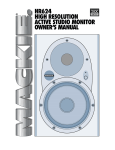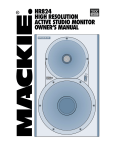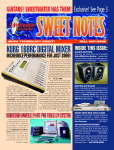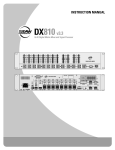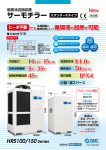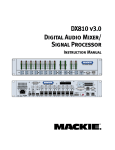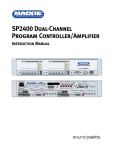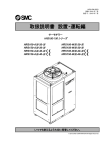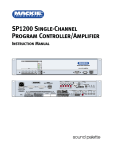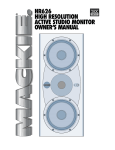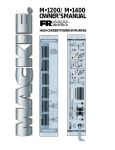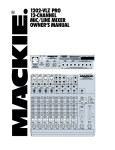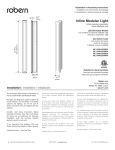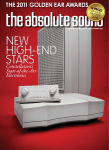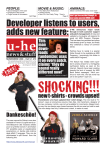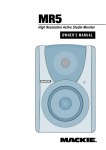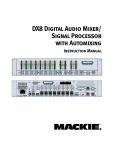Download Mackie HRS150 Owner`s manual
Transcript
HRS150 HIGH RESOLUTION POWERED SUBWOOFER OWNER’S MANUAL STANDARD SETTINGS INPUT/OUTPUT SUBSONIC FILTER POWER SUB BYPASSED FILTER BYPASS FLAT 15Hz SUBSONIC FILTER ( BYPASS FILTER SELECT FILTER BYPASS FILTER IN FULL RANGE FILTER SELECT VARIABLE 110Hz ELIPTICAL 5.1) LFE GAIN LFE GAIN INPUT SENSITIVITY POLARITY NORMAL 0dB LFE GAIN +10dB SUB SAT 80Hz INPUT SENSITIVITY CROSSOVER CONTROLS 0° 180° OFF POLARITY NORMAL LEFT SUB (MONO) IN SAT OUT THX PM3 SETTINGS 80Hz SUBSONIC FILTER 55Hz FILTER BYPASS 110Hz CROSSOVER (N/A) BYPASS FILTER SELECT L L IN OUT LFE GAIN INPUT SENSITIVITY POLARITY R SUB NORMAL R SUB SAT SAT 80Hz 80Hz 55Hz CROSSOVER CONTROLS 110Hz CROSSOVER IN OUT RIGHT ON SLAVE/MASTER SLAVE IN MASTER OUT S POWER M POLARITY & INPUT SENSITIVITY ACTIVE PROCESSED SIGNAL SUBWOOFER BYPASS FOOTSWITCH REMOTE INDICATOR OPEN - SUB ON, L/R BASS MANAGED CLOSED - SUB DEFEAT, L/R FULL RANGE *MAX OPEN CIRCUIT 24V *MAX CLOSED CIRCUIT 1A 120 VAC, 60 Hz, 950 WATTS REMOTE INDICATOR CIRCUIT CLOSED WHEN SUB BYPASSED "MACKIE", "FR SERIES", AND THE "RUNNING MAN" FIGURE ARE REGISTERED TRADEMARKSOF MACKIE DESIGNS, INC. "THX PM3" AND "LUCASFILM" ARE TRADEMARKS OF LUCASFILM, LTD. USED BY PERMISSION *TO INSURE PRODUCT SAFETY, POWER SUPPLIES MEETING CLASS-2 INSULATION REQUIREMENTS SHOULD ONLY BE USED WITH THIS CONNECTOR CAUTION CAUTION HEATSINK SURFACE HOT AVOID CONTACT HEATSINK SURFACE HOT AVOID CONTACT CAUTION RISK OF ELECTRIC SHOCK DO NOT OPEN ™ WARNING: TO REDUCE THE RISK OF FIRE OR ELECTRIC SHOCK, DO NOT EXPOSE THIS EQUIPMENT TO RAIN OR MOISTURE. DO NOT REMOVE COVER. NO USER SERVICEABLE PARTS INSIDE. REFER SERVICING TO QUALIFIED PERSONNEL. INTERNAL AMPLIFICATION 1050W AVIS: RISCQUE DE CHOC ÉLECTRIQUE — NE PAS OUVRIR SERIAL NUMBER MANUFACTURING DATE DESIGNED BY MACKOIDS IN WOODINVILLE, WA, USA ©2002 MACKIE DESIGNS INC. ALL RIGHTS RESERVED PATENTS PENDING R HIGH RESOLUTION LISTED COMMERCIAL AUDIO EQUIPMENT 9Z39 CAUTION AVIS RISK OF ELECTRIC SHOCK DO NOT OPEN RISQUE DE CHOC ELECTRIQUE NE PAS OUVRIR CAUTION: TO REDUCE THE RISK OF ELECTRIC SHOCK DO NOT REMOVE COVER (OR BACK) NO USER-SERVICEABLE PARTS INSIDE REFER SERVICING TO QUALIFIED PERSONNEL ATTENTION: POUR EVITER LES RISQUES DE CHOC ELECTRIQUE, NE PAS ENLEVER LE COUVERCLE. AUCUN ENTRETIEN DE PIECES INTERIEURES PAR L'USAGER. CONFIER L'ENTRETIEN AU PERSONNEL QUALIFIE. AVIS: POUR EVITER LES RISQUES D'INCENDIE OU D'ELECTROCUTION, N'EXPOSEZ PAS CET ARTICLE A LA PLUIE OU A L'HUMIDITE The lightning flash with arrowhead symbol within an equilateral triangle is intended to alert the user to the presence of uninsulated "dangerous voltage" within the product's enclosure that may be of sufficient magnitude to constitute a risk of electric shock to persons. Le symbole éclair avec point de flèche à l'intérieur d'un triangle équilatéral est utilisé pour alerter l'utilisateur de la présence à l'intérieur du coffret de "voltage dangereux" non isolé d'ampleur suffisante pour constituer un risque d'éléctrocution. The exclamation point within an equilateral triangle is intended to alert the user of the presence of important operating and maintenance (servicing) instructions in the literature accompanying the appliance. Le point d'exclamation à l'intérieur d'un triangle équilatéral est employé pour alerter les utilisateurs de la présence d'instructions importantes pour le fonctionnement et l'entretien (service) dans le livret d'instruction accompagnant l'appareil. SAFETY INSTRUCTIONS 1. Read Instructions — All the safety and operation instructions should be read before this Mackie product is operated. 2. Retain Instructions — The safety and operating instructions should be kept for future reference. 3. Heed Warnings — All warnings on this Mackie product and in these operating instructions should be followed. 4. Follow Instructions — All operating and other instructions should be followed. 5. Water and Moisture — This Mackie product should not be used near water – for example, near a bathtub, washbowl, kitchen sink, laundry tub, in a wet basement, near a swimming pool, swamp or salivating St. Bernard dog, etc. 6. Cleaning — Clean only with a dry cloth. 7. Ventilation — This Mackie product should be situated so that its location or position does not interfere with its proper ventilation. For example, the Component should not be situated on a bed, sofa, rug, or similar surface that may block any ventilation openings, or placed in a built-in installation such as a bookcase or cabinet that may impede the flow of air through ventilation openings. 8. Heat — This Mackie product should be situated away from heat sources such as radiators, or other devices which produce heat. 9. Power Sources — This Mackie product should be connected to a power supply only of the type described in these operation instructions or as marked on this Mackie product. 10. Power Cord Protection — Power supply cords should be routed so that they are not likely to be walked upon or pinched by items placed upon or against them, paying particular attention to cords at plugs, convenience receptacles, and the point where they exit this Mackie product. 11. Object and Liquid Entry — Care should be taken so that objects do not fall on, and liquids are not spilled into, this Mackie product. 12. Damage Requiring Service — This Mackie product should be serviced only by qualified service personnel when: A. The power-supply cord or the plug has been damaged; or B. Objects have fallen, or liquid has spilled into this Mackie product; or C. This Mackie product has been exposed to rain; or D. This Mackie product does not appear to operate normally or exhibits a marked change in performance; or E. This Mackie product has been dropped, or its chassis damaged. 13. Servicing — The user should not attempt to service this Mackie product beyond those means described in this operating manual. All other servicing should be referred to the Mackie Service Department. 14. To prevent electric shock, do not use this polarized plug with an extension cord, receptacle or other outlet unless the blades can be fully inserted to prevent blade exposure. Pour prévenir les chocs électriques ne pas utiliser cette fiche polariseé avec un prolongateur, un prise de courant ou une autre sortie de courant, sauf si les lames peuvent être insérées à fond sans laisser aucune pariie à découvert. 15. Grounding or Polarization — Precautions should be taken so that the grounding or polarization means of this Mackie product is not defeated. 16. Power Precaution — Unplug this Mackie product during lightning storms or when unused for long periods of time. Note that this Mackie product is not completely disconnected from the AC mains service when the power switch is in the OFF position. 17. This apparatus does not exceed the Class A/Class B (whichever is applicable) limits for radio noise emissions from digital apparatus as set out in the radio interference regulations of the Canadian Department of Communications. ATTENTION —Le présent appareil numérique n’émet pas de bruits radioélectriques dépassant las limites applicables aux appareils numériques de class A/de class B (selon le cas) prescrites dans le règlement sur le brouillage radioélectrique édicté par les ministere des communications du Canada. WARNING — To reduce the risk of fire or electric shock, do not expose this appliance to rain or moisture. • Please write the serial number for your HRS150 here for future reference (i.e., insurance claims, tech support, return authorization, etc.): Purchased at:_______________________________ Date of Purchase:_________________ 2 Lend Me Your Ears Exposure to extremely high noise levels may cause permanent hearing loss. Individuals vary considerably in susceptibility to noise-induced hearing loss, but nearly everyone will lose some hearing if exposed to sufficiently intense noise for a period of time. The U.S. Government’s Occupational Safety and Health Administration (OSHA) has specified the permissible noise level exposures shown in this chart. Duration Per Day In Hours Sound Level dBA, Slow Response 8 6 4 3 2 1.5 1 0.5 0.25 or less 90 92 95 97 100 102 105 110 115 INTRODUCTION Thank you for choosing Mackie Designs’ HRS150 Powered Subwoofer. We realize that monitors are a critically important tool whether your application is studio recording, audio/video post production, hi-fi, or home theater, and the use of a subwoofer not only improves low-frequency accuracy for stereo monitoring and playback, but is absolutely necessary for surround sound applications. The HRS150 complements our line of studio reference monitors and, like our HR824 and HR624, meets all THX™ requirements for mixing and monitoring multi-channel programs. In order to achieve a seamless integration between the subwoofer and the main speakers in the system, speaker placement is very important. The characteristics of the room and the location of the speakers, including the subwoofer, relative to the walls and your listening position can have a drastic effect on the accuracy of the sound. We’ve provided a section on positioning the subwoofers, offering tips on how to find the best placement for your particular application. What is it? The Advantages... The HRS150 is a high-resolution powered subwoofer employing an internal variable 4th-order Linkwitz-Riley crossover system with a down-firing RCF Precision 15“ woofer and two side-firing massloaded passive radiators. Whew! There are many benefits to integrating an active crossover, power amplifier, and drivers into a single cabinet, and we’ve taken full advantage of these benefits in the design of the HRS150. • The crossover point is variable so that the highpass output can be programmed to match the frequencies the main speakers are best able to reproduce. Part No. 0006805 Rev. B 5/03 ©2003 Mackie Designs Inc. All Rights Reserved. According to OSHA, any exposure in excess of these permissible limits could result in some hearing loss. To ensure against potentially dangerous exposure to high sound-pressure levels, it is recommended that all persons exposed to equipment capable of producing these levels use hearing protectors while this unit is in operation. Ear plugs or protectors in the ear canals or over the ears must be worn when operating this amplification system in order to prevent a permanent hearing loss if exposure is in excess of the limits set forth here. Typical Example Duo in small club Subway Train Very loud classical music The HRS150 can produce a maximum SPL of 122 dB @ 1 m Patrice screaming at Ron about deadlines Loudest parts at a rock concert • The amplifier is designed to provide maximum acoustic output from the speaker, yet minimize the danger of speaker damage due to overdriving. • The connecting wire between the amplifier output and the low-frequency driver is kept to an absolute minimum, so the damping factor of the amplifier isn’t compromised by the resistance of long speaker cables. In short, all the complex interconnected components in the system are designed to work in harmony with each other to produce the best possible sound. The Transducers... The subwoofer features a bottom-firing 15-inch die-cast frame woofer and a 15-inch passive radiator in the front. The unique passive radiator design provides a smooth response down to 19 Hz—an astounding accomplishment for a cabinet of this size! And since the radiator is complementing and adding to the output at the lowest frequencies, there is very little distortion generated from the woofer because its cone movement stays well within its maximum excursion. The Cabinet... The cabinet is made of black oak veneered MDF wood. Extensive internal bracing further increases the strength and rigidity (stiffness) of the box. The box is packed with an adiabatic polyester-fill material to absorb internal reflections and dampen standing waves. FR Series Power Amplifiers... What better way to power the subwoofer than with our acclaimed FR Series “Fast Recovery” power amplifiers. Our Fast Recovery design uses low negative feedback, yet allows the amplifier to maintain low distortion and stability even when driven into clipping. The low-frequency amplifier produces up to 950 watts continuous (1050 watts peak) before clipping. 3 QUICK START We realize that you can’t wait to hook up your new Mackie Designs HRS150 High Resolution Powered Subwoofer and try it out. Nevertheless, please take the time to read this page NOW, and the rest can wait until you’re good and ready. The HRS150 has its own built-in power amplifier. You should turn the INPUT SENSITIVITY control on the back of the cabinet down (fully counterclockwise) before turning on the HRS150 for the first time. Also be sure to set on the rear panel off the power switch (down). This will prevent you from accidentally connecting a hot signal source to the subwoofer and getting a rude surprise. There are a number of other settings you can make on the back of the HRS150, and you can read about them later on in this manual so you really know what they do. For now, just leave all the switches out, and the CROSSOVER controls set to the center position (80 Hz). For stereo applications: 1. Connect the left and right line-level signal from your mixer, preamp, or other signal jacks source to the LEFT and RIGHT IN on the HRS150 (XLR or RCA). 2. Connect the LEFT and RIGHT OUT jacks on the HRS150 (XLR or RCA) to the inputs of the left and right main powered speakers (or to the inputs of the amplifiers powering the left and right main speakers). 3. Connect the supplied AC power cord to the on the back of the IEC socket subwoofer. Plug the other end into an AC outlet properly configured with the correct voltage for your particular model. For surround sound applications: 1. Connect the LFE (Low-Frequency Effects) or subwoofer line-level signal from your mixer, preamp, or other signal source to the LEFT (MONO) IN jack on the HRS150 (XLR or RCA). switch to the 2. Set the FILTER BYPASS FULL RANGE position (pushed in). 3. Connect the supplied AC power cord to the on the back of the IEC socket subwoofer. Plug the other end into an AC outlet properly configured with the correct voltage for your particular model. 4 For stereo and surround sound applications: switch on the rear 4. Set the POWER panel to the ON position. The red POWER LED will turn on. 5. Turn on the power to the other components in the system. 6. Start your signal source (tape deck, CD, DAW, or whatever), but leave the master volume control on your mixer or preamp down. 7. Adjust the master volume on your mixer or preamp to a comfortably loud listening level. 8. Slowly turn up the INPUT SENSITIVITY control on the back of the HRS150 to its fully clockwise position (NORMAL), or until you achieve a balance between the subwoofer and the other speakers in the system. 9. Enjoy the authoritative, commanding lows of the HRS150. Then read the rest of this manual... especially the following (see page 6): Contents SAFETY INSTRUCTIONS ............................ 2 Lend Me Your Ears ................................... 3 INTRODUCTION ....................................... 3 QUICK START .......................................... 4 PLACEMENT ............................................ 6 REAR PANEL DESCRIPTION ...................... 8 POWER LED ........................................ 8 SUB BYPASSED LED ............................. 8 SUBSONIC FILTER ................................ 8 FILTER BYPASS ................................... 8 FILTER SELECT ..................................... 8 LFE GAIN ............................................ 8 INPUT SENSITIVITY ............................. 8 POLARITY ........................................... 9 LEFT AND RIGHT INPUTS ..................... 9 LEFT AND RIGHT OUTPUTS .................. 9 CROSSOVER ....................................... 9 MASTER OUT/SLAVE IN .................... 10 SUBWOOFER BYPASS FOOT SWITCH . 10 REMOTE INDICATOR ......................... 10 POWER ............................................ 11 MAINS INPUT ................................... 11 HOOKUP DIAGRAM ............................... 11 PROTECTION CIRCUITS .......................... 12 CONNECTIONS....................................... 12 SERVICE INFO ....................................... 13 TECHNICAL INFORMATION ..................... 15 COLOPHON ........................................... 18 HRS150 LIMITED WARRANTY ................ 19 INPUT/OUTPUT POWER SUB BYPASSED FLAT 15Hz SUBSONIC FILTER FILTER BYPASS FILTER IN FULL RANGE FILTER SELECT VARIABLE 110Hz ELIPTICAL THX PM3 SETTINGS SUBSONIC FILTER 0dB LFE GAIN +10dB FILTER BYPASS INPUT SENSITIVITY FILTER SELECT 0° 180° OFF LFE GAIN POLARITY INPUT SENSITIVITY NORMAL LEFT SUB (N/A) POLARITY (MONO) IN SAT NORMAL OUT 80Hz SUB SAT 80Hz CROSSOVER CONTROLS 55Hz 110Hz CROSSOVER SUB L L IN OUT R R SAT ON 80Hz POWER 55Hz 110Hz CROSSOVER IN OUT RIGHT SLAVE/MASTER SLAVE IN MASTER OUT S M 120 VAC, 60 Hz, 950 WATTS POLARITY & INPUT SENSITIVITY ACTIVE PROCESSED SIGNAL SUBWOOFER BYPASS FOOTSWITCH REMOTE INDICATOR OPEN - SUB ON, L/R BASS MANAGED CLOSED - SUB DEFEAT, L/R FULL RANGE *MAX OPEN CIRCUIT 24V *MAX CLOSED CIRCUIT 1A REMOTE INDICATOR CIRCUIT CLOSED WHEN SUB BYPASSED *TO INSURE PRODUCT SAFETY, POWER SUPPLIES MEETING CLASS-2 INSULATION REQUIREMENTS SHOULD ONLY BE USED WITH THIS CONNECTOR "MACKIE", "FR SERIES", AND THE "RUNNING MAN" FIGURE ARE REGISTERED TRADEMARKSOF MACKIE DESIGNS, INC. "THX PM3" AND "LUCASFILM" ARE TRADEMARKS OF LUCASFILM, LTD. USED BY PERMISSION CAUTION HEATSINK SURFACE HOT AVOID CONTACT 5 PLACEMENT AN IMPORTANT NOTE ON HRS150 BASS RESPONSE AND YOUR CONTROL ROOM OR LISTENING ROOM You’ve heard it before. “Low-frequencies are non-directional, so it doesn’t matter where you place the subwoofer.” Although it is true that frequencies below about 100 Hz are non-directional, it is also true that a lot of factors can conspire to thwart the HRS150’s extended low frequency — including room shape, room volume, and acoustical treatment. This is not a cop-out or an apology. It’s plain old physics in action. Here are some tips to help you find the best placement for your HRS150 and optimize the low-frequency response in your particular room. Consider the following: Room acoustics and bass-handling ability Nobody likes to buy a subwoofer and a new set of speakers and then be told that they should spend extra bucks on bass traps or a remodeling job. But the simple fact is, “standard” rooms, i.e., rectangular rooms in conventional business or residential structures, are rarely if ever conducive to optimal low bass reproduction without some modifications. However, understanding what can cause degradation of the low-frequency response in a room can help in choosing a location that can minimize the problems associated with poor bass response most notably interference and resonance. Interference is caused when the reflected wave from the surrounding walls arrive out-ofphase with the direct sound. This can weaken or even cancel the sound. Keeping the distance between the subwoofer driver and any adjacent walls no longer than 1/8 of a wavelength (20 in. or 51 cm at 80 Hz) can minimize interference. Room resonance is caused by the reinforcement of certain frequencies between 20 Hz and 200 Hz, which creates “standing waves” or room modes. These resonant frequencies are determined by the dimensions of the room. The bass response is sharply boosted for a narrow band near resonance, and then appears to be attenuated between resonances. 6 Corner or Center Placement Placing the subwoofer in a corner (corner loading) excites the most room modes in the room, which tends to smooth the individual peaks and dips caused by each standing wave. Moving the subwoofer outward from the corner along the wall results in fewer standing waves, but may result in noticeable peaks at certain frequencies. Some people prefer to place the subwoofer between the left and right main speakers, so that all the sound is coming from the same plane. Some prefer to use two subwoofers and place one with the left speaker and the other with the right speaker. The Master Out/Slave In connections on the HRS150 allow you to do this quite easily. Another benefit of corner placement is increased efficiency and lower distortion. The energy that is reflected off the walls reinforces the direct sound, putting less of a demand on the power amplifier to reach higher sound pressure levels. It is important that the corner has good structural strength, or the low-frequency energy can cause rattling and other distracting vibrations. Experiment with the orientation of the subwoofer. The driver in the HRS150 faces downward toward the floor while the passive radiators face out the sides. It may be helpful to play steady-state tones or pink noise while a partner moves the subwoofer (perhaps on a small wheeled cart), to make it easier to hear the differences in the sound as the changes in placement and orientation are made. Principle of Reciprocity One trick that has been used successfully to find the best location for a subwoofer is placing the subwoofer in your listening position. The principle of reciprocity says that you can find the best location for the subwoofer by switching places between the listening position and the subwoofer position. It is important that the cabinet be raised off the ground and at the same level as your ears. If that’s not possible, at least put the subwoofer in the same location as your listening position to achieve a close approximation. Play music with a good strong bass line and crawl on the floor on your hands and knees until you find a spot where the bass sounds the best, with a smooth, tight response. Your ears need to be at the same height that the subwoofer’s driver will be when it is sitting on the floor. If you have access to a real-time analyzer (RTA), play pink noise over the system and use the RTA to find a location that exhibits the flatest bass response. Once you’ve found the place where the bass sounds the best, put the subwoofer there and it should sound just as good from your listening position. Polarity The setting of the polarity switch can affect how the low frequencies sound in relation to the main speakers. Listen to bass-heavy music with the polarity switch in and out. In one position the low frequencies should sound full, while in the other position they may sound hollow and thin. Choose the position that yields the fullest low-frequency sound. Feel free to experiment In many respects, every room is unique in terms of its acoustics. Even after you’ve placed your subwoofer where you think it’ll sound best, try moving it around. You might be pleasantly surprised. Additional Tidbits of Wisdom • Avoid using EQ to compensate for dips in the frequency response caused by room modes. It is better to place the subwoofer in a position where dips are minimized and use the EQ to smooth out any peaks. • Provide at least six inches clearance around the heatsink to allow air to get at it. • Provide at least three feet clearance from a TV, computer monitor, or any form of magnetic media (video and audio recording tapes, computer disks, etc.), to prevent the HR150’s powerful magnet from distorting the video screen or erasing the magnetic media. • When you shut down your equipment, turn off the HRS150 powered subwoofer first (and any other powered speakers in the system) to prevent thumps and other noises generated by any upstream equipment from coming out the speakers. When powering up, turn on the powered speakers and subwoofer last. • Save the shipping box! You may need it someday, and you don’t want to have to pay for another one. • Save your sales receipt in a safe place. • Also record the HRS150 serial number in the space provided on the inside front cover, along with where and when you bought it. A Few Words About THX™ pm3™ Certification Nearly two decades ago, George Lucas turned a passion for great sound into the world’s most accepted and trusted solution for achieving it. The standard was named THX (for Tomlinson Holman, who developed the THX Sound System when he was the research and technical director at Lucasfilm Ltd.™ in the early 80s), and today, with hundreds of thousands of home theater customers and more than 3000 THX Certified movie theaters enjoying its benefits, the THX name has become nothing short of legendary. Simply put: when it comes to premium sound, no other name so closely defines ‘quality’ for millions of movie-goers and home theater enthusiasts alike. Today, a new landscape is emerging. A landscape comprised of hundreds of small, professional multi-channel facilities, whose need for differentiation, expert technical and marketing support, and a true, multi-channel standard is becoming a competitive fact of life. Again, THX has a singular solution and this time it’s called THX pm3 Certification. All facilities involved with mixing and/or monitoring of multi-channel material should have the option to use pm3. THX pm3 Certification is ideal for DVD mastering, sweetening, and mixing; and is also perfect for facilities doing work in broadcast, music, or multi-media applications. HRS150 THX pm3 Certification Anyone seeking THX Certification for their studio, or striving to maintain THX standards, can use the HRS150s and rest assured that their facility is in full compliance. 7 REAR PANEL DESCRIPTION This is where you connect your signal inputs and outputs to the subwoofer, and make adjustments to the crossover, filters, and input sensitivity. For THX applications, the rear panel switches and controls should be set to the THX positions as indicated on the rear panel. POWER LED The POWER LED lights when the power switch is turned on and the subwoofer is operating normally. If there is no signal present for several minutes, the HRS150 goes into bypass mode, the POWER LED turns off, and the SUB BYPASSED LED turns on. The instant a signal appears at its input, the HRS150 comes to life and the POWER LED lights again. SUB BYPASSED LED When the SUBWOOFER BYPASS circuit is activated by either the auto-off circuit or the FOOTSWITCH connection, the SUB BYPASSED LED lights. SUBSONIC FILTER SUBSONIC FILTER FLAT 15Hz THX = FLAT Push this switch in to engage the 3rd-order 18 dB/octave Butterworth subsonic filter, which rolls off frequencies below 15 Hz. This eliminates unwanted low-frequency energy so that all the power from the HRS150 amplifier is dedicated to useful low frequencies. FILTER SELECT VARIABLE 110Hz ELLIPTICAL FILTER SELECT This switch selects either the built-in 4th-order 24 dB/octave Linkwitz-Riley variable crossover or the 7th-order 42 dB/octave 110 Hz elliptical low-pass filter for the subwoofer. Use the elliptical filter when mixing for surround sound applications with a LFE channel. This steep filter emulates the “brick-wall” lowpass filter used in AC-3 and DTS formats. Use the variable crossover filter for normal playback of stereo sound. LFE GAIN 0dB LFE GAIN +10dB THX = 0 dB For Surround Sound Mixing: Push this switch in to add 10 dB of gain to the subwoofer signal. This allows you to record the LFE channel at –10 dB relative to the other channels, as specified by AC-3 encoding standards. Note that 10 dB of gain is added back when decoding the LFE channel. For Playback: Push this switch in to add 10 dB of gain to the subwoofer signal. This is useful for home theater applications where the LFE channel requires additional gain to balance with the other channels in the surround sound system. INPUT SENSITIVITY INPUT SENSITIVITY FILTER BYPASS OFF FILTER BYPASS FILTER IN FULL RANGE THX = FULL RANGE This switch bypasses the built-in low-pass filters (variable and elliptical). Push this switch in when connecting an LFE or subwoofer output signal from a mixer or preamp to the LEFT(MONO) and/or RIGHT inputs, to avoid “double-filtering” the low-frequency signal. Note that the LEFT(MONO) and RIGHT OUTputs are still high-pass filtered and affected by the CROSSOVER controls. 8 NORMAL THX = NORMAL The HRS150 expects a line-level signal at its input connectors. • The sensitivity is 89 dB SPL at one meter with a 100 mV (–17.8 dBu) input signal, with the INPUT SENSITIVITY control set to its NORMAL position (in other words, wide open). • The HRS150 is designed to operate with a nominal +4 dBu signal when the INPUT SENSITIVITY control is in the NORMAL position. • Refer to the QUICK START section on page 4 for the level-setting procedure. POLARITY 0° 180° POLARITY THX = 0˚ This switch reverses the polarity of the signal going to the subwoofer amplifier by 180º. It has no effect on the signal at the LEFT and RIGHT OUT or the MASTER OUT. There is no right or wrong setting for this switch. Listen to the overall blend of the subwoofer with the rest of the system, and select the switch position that gives you the best sound. INPUT/OUTPUT POWER SUBSONIC FILTER FILTER IN FULL RANGE FILTER BYPASS FILTER BYPASS FILTER SELECT VARIABLE 110Hz ELIPTICAL FILTER SELECT INPUT SENSITIVITY +10dB POLARITY NORMAL INPUT SENSITIVITY SUB SAT 80Hz 55Hz 110Hz CROSSOVER 0° 180° OFF CROSSOVER CONTROLS POLARITY NORMAL LEFT SUB (MONO) IN SAT OUT 80Hz 55Hz 110Hz CROSSOVER SUB L L IN OUT R R SAT 80Hz 55Hz 110Hz CROSSOVER IN OUT RIGHT SLAVE/MASTER SLAVE IN MASTER OUT S M POLARITY & INPUT SENSITIVITY ACTIVE PROCESSED SIGNAL SUBWOOFER BYPASS FOOTSWITCH REMOTE INDICATOR OPEN - SUB ON, L/R BASS MANAGED CLOSED - SUB DEFEAT, L/R FULL RANGE *MAX OPEN CIRCUIT 24V *MAX CLOSED CIRCUIT 1A REMOTE INDICATOR CIRCUIT CLOSED WHEN SUB BYPASSED THX = 80 Hz This adjusts the crossover frequency for the built-in 24 dB/octave Linkwitz-Riley variable crossover. The crossover frequency can be adjusted from 55 Hz to 110 Hz. SAT 80Hz CROSSOVER SUB (N/A) LFE GAIN 0dB LFE GAIN LEFT AND RIGHT OUTPUTS Balanced XLR male and unbalanced RCA female connectors are provided for the line-level left and right high-pass outputs. Connect these to the inputs of the main speakers (if they are powered speakers) or to the inputs of the amplifier powering the main speakers. The signal at the left and right outputs is post-crossover. The low-pass output from the crossover goes to the internal power amplifier in the HRS150, while the high-pass output goes to these output jacks. THX PM3 SETTINGS SUBSONIC FILTER LEFT AND RIGHT INPUTS Balanced XLR female and unbalanced RCA female connectors are provided for the left and right inputs. Connect the full-range line-level signal from the mixer or preamplifier to one of these input jacks. The connectors are wired as follows (per the AES/IEC standard): XLR RCA Hot (+) Pin 2 Tip Cold (–) Pin 3 — Shield (Ground) Pin 1 Shield If connecting a single subwoofer or LFE output to the HRS150, use the LEFT (MONO) input with the FILTER BYPASS switch pushed in. SUB BYPASSED FLAT 15Hz *TO INSURE PRODUCT SAFETY, POWER SUPPLIES MEETING CLASS-2 INSULATION REQUIREMENTS SHOULD ONLY BE USED WITH THIS CONNECTOR 9 Frequencies below the crossover frequency are sent to the subwoofer, and frequencies above the crossover frequency are sent to the LEFT and RIGHT OUTputs, which are connected to the main/satellite speakers. Set the crossover frequency to the lowest frequency response rating of the main/satellite speakers. across the tip/sleeve when the internal relay is open, and a maximum 1 amp of current when the relay is closed. CAUTION: There is an internal 1A fuse to protect the REMOTE INDICATOR circuit. Exceeding 1A of current may blow the internal 1A fuse. MASTER OUT/SLAVE IN Balanced XLR and unbalanced RCA female connectors are provided for the MASTER OUT/ SLAVE INputs. Use these for daisy-chaining two HRS150s by connecting the MASTER OUT jack from the first subwoofer to the SLAVE IN jack on the second subwoofer (see note below). The SLAVE IN bypasses all filtering, but is affected by the POLARITY and INPUT SENSITIVITY settings. The MASTER OUT is post-filtering (variable and elliptical crossover, subsonic filter, and LFE gain) and pre- POLARITY and INPUT SENSITIVITY. Note: You cannot daisy-chain more than one additional subwoofer using these connections. If SLAVE IN is used as an input, the MASTER OUT has no signal present. To connect more subwoofers, connect the MASTER OUT from the first subwoofer to the LEFT (MONO) INput of the second subwoofer with the FILTER BYPASS switch pushed in. Then connect the MASTER OUT of the second subwoofer to the LEFT (MONO) INput of the third subwoofer, and so on. SUBWOOFER BYPASS FOOT SWITCH This is a 1/4" jack for connecting a normallyopen footswitch. When the switch is closed, the subwoofer is muted and the LEFT and RIGHT OUTputs pass the full-range signal to the main/satellite speakers. This is useful for making a quick comparison between the HRS150 enhanced and non-enhanced low-frequency playback. LEFT SUB 10 OUT 80Hz 55Hz 110Hz CROSSOVER SUB L L IN OUT R R SAT 80Hz 55Hz 110Hz CROSSOVER IN OUT RIGHT SLAVE/MASTER SLAVE IN MASTER OUT S M POLARITY & INPUT SENSITIVITY ACTIVE PROCESSED SIGNAL SUBWOOFER BYPASS FOOTSWITCH REMOTE INDICATOR OPEN - SUB ON, L/R BASS MANAGED CLOSED - SUB DEFEAT, L/R FULL RANGE *MAX OPEN CIRCUIT 24V *MAX CLOSED CIRCUIT 1A REMOTE INDICATOR This is a 1/4" jack for connecting a remote indicator to indicate when the subwoofer is bypassed. An internal relay closes, shorting the tip and sleeve of the REMOTE INDICATOR jack whenever the subwoofer is in bypass mode, either triggered manually with the FOOT SWITCH or by the auto-off function. This can be used to turn on a remote, lowvoltage lamp. Note that this jack does not provide power. It accepts a maximum of 24 VDC (MONO) IN SAT ON POWER 120 VAC, 60 Hz, 950 WATTS POWER Use this switch to turn the HRS150 on and off. The subwoofer is muted for about three seconds after the HRS150 is turned on while the power supply and internal circuitry stabilize. The auto on/off circuit is disabled when the POWER switch is off. MAINS INPUT Connect the power cord to this IEC socket, and plug the other end into your AC outlet. Make sure the outlet is properly configured for the voltage rating of your model. HOOKUP DIAGRAM Left Main/Satellite Powered Speaker Right Main/Satellite Powered Speaker STANDARD SETTINGS INPUT/OUTPUT SUBSONIC FILTER POWER L SUB BYPASSED FILTER BYPASS FLAT 15Hz SUBSONIC FILTER ( BYPASS FILTER SELECT FILTER BYPASS FILTER IN FULL RANGE FILTER SELECT VARIABLE 110Hz ELIPTICAL LFE GAIN 5.1) LFE GAIN INPUT SENSITIVITY POLARITY NORMAL 0dB LFE GAIN +10dB SUB SAT 80Hz INPUT SENSITIVITY CROSSOVER CONTROLS 0 180 OFF POLARITY NORMAL LEFT SUB R (MONO) IN SAT OUT THX PM3 SETTINGS 80Hz SUBSONIC FILTER 55Hz FILTER BYPASS 110Hz CROSSOVER (N/A) BYPASS FILTER SELECT Surround Sound Preamplifier OR L From Mixer or Preamplifier Outputs R L L IN OUT R R LFE GAIN INPUT SENSITIVITY POLARITY SUB NORMAL SUB SAT SAT 80Hz 80Hz 55Hz CROSSOVER CONTROLS 110Hz CROSSOVER IN OUT RIGHT ON SLAVE/MASTER SLAVE IN MASTER OUT S POWER M POLARITY & INPUT SENSITIVITY ACTIVE PROCESSED SIGNAL SUBWOOFER BYPASS FOOTSWITCH REMOTE INDICATOR OPEN - SUB ON, L/R BASS MANAGED CLOSED - SUB DEFEAT, L/R FULL RANGE *MAX OPEN CIRCUIT 24V *MAX CLOSED CIRCUIT 1A 120 VAC, 60 Hz, 950 WATTS REMOTE INDICATOR CIRCUIT CLOSED WHEN SUB BYPASSED *TO INSURE PRODUCT SAFETY, POWER SUPPLIES MEETING CLASS-2 INSULATION REQUIREMENTS SHOULD ONLY BE USED WITH THIS CONNECTOR CAUTION "MACKIE", "FR SERIES", AND THE "RUNNING MAN" FIGURE ARE REGISTERED TRADEMARKSOF MACKIE DESIGNS, INC. "THX PM3" AND "LUCASFILM" ARE TRADEMARKS OF LUCASFILM, LTD. USED BY PERMISSION CAUTION HEATSINK SURFACE HOT AVOID CONTACT HEATSINK SURFACE HOT AVOID CONTACT To Optional 2nd HRS150 Slave Input CAUTION ™ RISK OF ELECTRIC SHOCK DO NOT OPEN WARNING: TO REDUCE THE RISK OF FIRE OR ELECTRIC SHOCK, DO NOT EXPOSE THIS INTERNAL AMPLIFICATION 1050W EQUIPMENT TO RAIN OR MOISTURE. DO NOT REMOVE COVER. NO USER SERVICEABLE PARTS INSIDE. REFER SERVICING TO QUALIFIED PERSONNEL. AVIS: RISCQUE DE CHOC ÉLECTRIQUE — NE PAS OUVRIR SERIAL NUMBER MANUFACTURING DATE DESIGNED BY MACKOIDS IN WOODINVILLE, WA, USA ©2002 MACKIE DESIGNS INC. ALL RIGHTS RESERVED PATENTS PENDING Mixing Console (1604-VLZ PRO shown) 11 PROTECTION CIRCUITS CONNECTIONS There are several protection mechanisms designed into the HRS150 to safeguard the loudspeaker and amplifier from inadvertent damage. Peak Limiter A peak limiter is located at the input to the power amplifier section. It monitors both the amplifier output signal and the power supply voltages to guard against clipping and overloading the amplifier. This allows for loud and punchy bass performance without distortion, ensuring long-term reliability. Thermal Protect All amplifiers produce heat. The HRS150 is designed to be efficient both electrically and thermally. • If for some reason the heatsink or power transformer gets too hot, a thermal switch activates, placing the HRS150 into Standby mode. • Should this happen, make sure that airflow to the rear of the cabinet is not restricted. • When the heatsink or power transformer cools down to a safe temperature, the switch resets and normal operation resumes. Note: The POWER LED remains lit if the thermal protection circuit is activated. 12 Input and Output Signal Wiring You should use high-quality, shielded cable to connect the signal source to the LEFT and RIGHT IN and OUT jacks on the HRS150. • Foil shielded cables, such as Belden 8451, 8761, or 9501 are commonly used for studio wiring. • Microphone cables work well. • The better the shield, the better the immunity from externally induced noise (like EMI and RFI). Route the cable away from AC power cords and outlets. These are common sources for hum in an audio signal. Wall warts and line lumps are especially insidious hum inducers! You can purchase quality cables from your Mackie dealer. • In certain home theater applications, it may be necessary to connect the speaker outputs from a stereo receiver to the inputs of the HRS150s, if the receiver doesn’t have preamp outputs or other line-level output connections. CAUTION: Do not attempt to connect a speaker output directly to the input of the HRS150! Speaker levels are much higher than line levels and can damage the input circuitry in the HRS150. You can, however, insert a speaker-level to line-level signal attenuator between the receiver’s speaker output and the HRS150’s input. Your Mackie dealer may be able to help you find one, or you can build your own. Contact our tech support department for more information. SERVICE INFO Details concerning Warranty Service are spelled out on the Warranty Card included with your subwoofer (if it’s missing, let us know and we’ll rush one to you). If you think your subwoofer has a problem, please do everything you can to confirm it before calling for service, including reading through the following Troubleshooting section. Doing so might save you from deprivation of your monitor and the associated suffering. Of all Mackie products returned for service (which is hardly any at all), roughly 50% are coded “CND” — Could Not Duplicate, which usually means the problem lay somewhere else in the system. These may sound obvious to you, but here are some things you can check: Troubleshooting No Power • Our favorite question: Is it plugged in? • Make sure the power cord is securely and plugged seated in the IEC socket all the way into the AC outlet. • Make sure the AC outlet is live (check with a tester or lamp). • Is the POWER switch on the rear panel in the ON position? LED or BYPASSED • Is the POWER LED on the rear panel illuminated? If not, make sure the AC outlet is live. If so, refer to “No Sound” below. LED • If the POWER LED or BYPASSED is not illuminated, and you are certain that the AC outlet is live, it will be necessary to have the HRS150 serviced. There are no user-serviceable parts inside. Refer to “Repair” at the end of this section to find out how to proceed. No Sound • Is the POWER LED or BYPASSED LED on the rear panel illuminated? If not, refer to “No Power” above. control • Is the INPUT SENSITIVITY turned up? • Is the signal source turned up? Make sure the signal level from the mixing console (or whatever device immediately precedes the subwoofer) is high enough to produce sound. Bad Sound • Is the input connector plugged completely into the jack? • Is it loud and distorted? Reduce the signal level at the mixer. • If possible, listen to the signal source with headphones plugged into the preamp stage. If it sounds bad there, it’s not the subwoofer. • Too much bass or not enough bass? Move around the room and see if the bass response changes. It’s possible your listening position coincides with a room mode where the low frequencies either become exaggerated or nulled. If so, try moving the subwoofer to a different position, or moving your listening position. • If the signal source is an LFE or subwoofer output from a home theater preamplier, make sure the signal level for the lowfrequency output is turned up in the preamp. If you have connected the lowfrequency signal to the LEFT (and RIGHT) INput, make sure the FILTER BYPASSED switch is pushed in. Noise/Hum/Buzz • Check the signal cable between the mixer/ preamp and the subwoofer. Make sure all connections are secure. These problems usually produce crackling noises, hum, or buzz. • If connecting an unbalanced output to the HRS150 balanced input, make sure the shield is connected to both pins 1 and 3 on the XLR. • If a CATV cable is connected to the system, try disconnecting it. If the hum goes away, call your cable carrier to check for proper grounding of the cable. • Make sure the signal cable is not routed near AC cables, power transformers, or other EMI sources (including wall warts and line lumps!). These sources usually produce hum. • Is there a light dimmer or other triac-based device on the same AC circuit as the monitor? Dimmers cause buzzing noises. Use an AC line filter or plug the subwoofer into a different AC circuit. • If possible, listen to the signal source with headphones plugged in. If it sounds noisy there, it’s not the subwoofer. 13 Repair Service for the U.S. versions of the HRS150 is available only from our factory service center located in sunny Woodinville, Washington. Service outside the United States can be obtained through local dealers or distributors. If your HRS150 needs service, follow these instructions: 1. Review the preceding troubleshooting suggestions. Please. 2. Call Tech Support at 1-800-258-6883, 7 am to 5 pm PST, to explain the problem and request an RA (Return Authorization) number. Have your subwoofer’s serial number ready. You must have an RA number before you can obtain service at the factory. 3. Set aside the power cord, owner’s manual, or anything else that you’ll ever want to see again. We are responsible for the return of the subwoofer only. 4. Pack the subwoofer in its original packing box. This is very important. When you call for the RA number, please let Tech Support know if you need new packaging. Mackie is not responsible for any damage that occurs due to non-factory packaging. 5. Include a legible note stating your name, shipping address (no P.O. boxes), daytime phone number, RA number, and a detailed description of the problem, including how we can duplicate it. 6. Write the RA number in BIG PRINT on top of the box. 14 7. Ship the subwoofer to us. We suggest insurance for all forms of cartage. Ship to this address: Mackie Designs SERVICE DEPARTMENT 16220 Wood-Red Road NE Woodinville, WA 98072 8. We’ll try to fix the subwoofer in three to five business days. Ask Tech Support for current turnaround times when you call for your RA number. The product MUST be packaged in its original packing box and have the RMA number appear on the box. Once it is repaired, we’ll ship it back the same way in which it was received. This paragraph does not necessarily apply to non-warranty service. 3 2 3 2 3 2 MACKIE DESIGNS HRS150 THX BLOCK DIAGRAM (#061702JW) OUT HPF FROM CROSSOVER AT LEFT AND RIGHT OUTPUTS SUBWOOFER ACTIVE REMOTE INDICATOR SWITCH OPEN FULL-RANGE SIGNAL FROM INPUTS AT LEFT AND RIGHT OUTPUTS SUBWOOFER MUTED REMOTE INDICATOR SWITCH CLOSED OUTPUT IS INACTIVE WHEN NO SIGNAL IS PRESENT AND BECOMES ACTIVE AFTER SIGNAL RETURNS. OUTPUT REMAINS ACTIVE FOR SEVERAL MINUTES AFTER SIGNAL IS REMOVED. WHEN SIGNAL IS PRESENT THE OUTPUT IS ACTIVE. IN INPUT SIGNAL DETECTOR 110Hz 42 dB/OCT ELLIPTICAL LPF (FOR AC-3/DTS) FULL RANGE (THX) FILTER IN 110Hz ELLIPTICAL FILTER BYPASS FILTER SELECT 55Hz-110Hz OPEN = CROSSOVER FREQ 55Hz-110Hz 24 dB/OCT LINKWITZ-RILEY CENTER POSITION (80Hz) FOR THX CROSSOVER FREQ CLOSED = "POLARITY" AND "INPUT SENSITIVITY" ONLY ARE ACTIVE ON THIS INPUT. NOTE: WHEN USED AS A SLAVE, THE MASTER OUTPUT OF THE FIRST SUB DRIVES THIS INPUT. 1 1 1 SUBWOOFER BYPASS FOOTSWITCH SLAVE INPUT RIGHT LINE INPUT LEFT/MONO LINE INPUT POWER 15Hz 18 dB/OCT BUTTERWORTH LPF 15Hz FLAT (THX) SUBSONIC FILTER Av = 10 dB +10 dB 0 dB (THX) LFE GAIN SUB BYPASSED A B CTL A B CTL A B CTL +5V OUT OUT OUT 180º 0º (THX) POLARITY POWER SUPPLY TRACKING/ PEAK POWER LIMITER FAST ATTACK/SLOW RELEASE COMPRESSOR INPUT SENSITIVITY (CW = THX) IN ACE-BASS EQ OUT FUSE POWER AMPLIFIER 2 1 3 2 1 SUBWOOFER 3 1 THE POTENTIAL ON THESE TERMINALS MUST BE FLOATING OR REFERENCED TO SAFETY GROUND MAXIMUM CURRENT ALLOWED THROUGH CLOSED SWITCH = 1A MAXIMUM VOLTAGE ALLOWED ACROSS OPEN CONTACTS = 24V CLOSED WHEN SUBWOOFER IS MUTED SENSE RESISTOR –15V –90V –100V +100V +90V +15V 2 3 SUBWOOFER BYPASS REMOTE INDICATOR MASTER OUTPUT RIGHT LINE OUTPUT LEFT/MONO LINE OUTPUT TECHNICAL INFORMATION HRS150 Block Diagram 15 Specifications Transducers Acoustic Section Low-frequency driver Diameter: 15 in/381 mm Acoustic Frequency Response: 20 Hz to 150 Hz, ±1.5 dB Sensitivity: 96 dB SPL (1 W, 1 M) –3 dB points: 19 Hz, 250 Hz Maximum SPL: 122 dB @ 1 meter Residual Noise: < 8 dBA SPL Nominal Impedance: 8 ohms Voice Coil Diameter: 4 in/100 mm Power Handling (Long Term/Program): 400/1000 watts Frequency Range: 20 Hz to 500 Hz Frame: Die Cast Magnet: Ferrite Power Amplifier Section Rated Power Output (1% THD at 100 Hz): 950 watts rms into rated 8Ω load Peak Power Output (100 Hz sine, Per RS-490): 1050 watts THD (20 Hz to 300 Hz from 1 W to –1 dBr = 750 W): < 0.05% (typically 0.007%) Passive Radiators (2) Rated Load Impedance: 8 Ω Diameter: Signal-to-Noise Ratio: 107 dBr (0 dBr = 750 W) 12 in/305 mm mass-loaded System Specifications Crossover Type: Linkwitz-Riley, 24 dB/octave, variable 55 Hz to 110 Hz Input Type: Balanced Differential (XLR), Unbalanced (RCA) Input Impedance: 20 kΩ (Bal) , 10 kΩ (UnBal) Input Sensitivity: 89 dB SPL with a 100 mV (–17.8 dBu) input signal level (LFE gain set to 0 dB) Input Protection: RFI and Level Protected Maximum Input Level: +20 dBu Signal Sense Threshold: –74 dBu (0.155 mV) Power Bandwidth (at 750 W): –0.5 dB at 10 Hz –3.0 dB at 55 kHz Damping factor (referenced to 8 Ω): > 1000 Turn-On delay: 3-4 Seconds Cooling: Convection Line Input Power: US Europe Japan Korea Materials: Subsonic Filter: 15 Hz, 3rd-Order Butterworth HPF Output Type: Balanced (XLR), Unbalanced (RCA) Internal Volume: Height (w/ feet): Width: Depth: Weight: Over-Excursion Prevention: Subsonic Filter (Flat Position: 2nd-Order HPF, 15 Hz Position: 5th-Order HPF) Driver Protection: Power Supply Tracking Peak Limiter Thermal Protection: Heatsink and Transformer Temperature, Auto Reset 23.6 in/599 mm 22.0 in/558 mm 60 Hz 50 Hz 50-60 Hz 60 Hz 950 W 950 W 950 W 950 W Physical Properties High-Cut Filter (LFE): 110 Hz, 7th-order Elliptical Filter Output Impedance: 240 Ω (Bal) , 120 Ω (Unbal) 120 VAC 240 VAC 100 VAC 220 VAC 0.75“ MDF construction with black oak veneer 3.88 cu ft/110 liters 24.0 in/609 mm 23.7 in/601 mm 23.6 in/599 mm 117 lb/53 kg Operating Temperature Range: –10°C to 30°C Mackie Designs is always striving to improve our products by incorporating new and improved materials, components and manufacturing methods. Therefore, we reserve the right to change these specifications at any time without notice. 23.7 in/601 mm HRS150 WEIGHT 117 lb/ 53 kg 24.0 in/ 609 mm 22.0 in/ 559 mm HIGH RESOLUTION 16 Graphs HRS150 Crossover Filter Response +10 +8 +6 +4 +2 -0 -2 -4 -6 -8 -10 -12 -14 dBr -16 -18 -20 -22 -24 -26 -28 -30 -32 55Hz 80Hz 110Hz -34 -36 -38 -40 10 20 50 100 200 500 1k 2k 5k 10k 20k Hz HRS150 Elliptical Filter Response +10 +8 +6 +4 +2 -0 -2 -4 -6 -8 -10 -12 -14 dBr -16 -18 -20 -22 -24 -26 -28 -30 -32 -34 -36 -38 -40 20 50 100 200 500 1k 2k 5k 10k 20k Hz HRS150 Free-Field Frequency Response (THX pm3 setting) +10 +8 +6 +4 +2 +0 -2 -4 -6 -8 -10 -12 -14 dBr -16 -18 -20 -22 -24 -26 -28 -30 -32 -34 -36 -38 -40 20 30 40 50 60 70 80 90 100 200 300 400 500 Hz 17 COLOPHON The text is a compilation based on input from a number of sources including Cam Jones, Terry Wetherbee, Marcelo Vercelli, and Keith Olsen. Dave Franzwa and Jayney Wallick produced this manual using the following tools: Initially written in Microsoft® Word 98 for the Macintosh, the text was imported into Adobe PageMaker® 6.5. Illustrations were produced in Adobe Illustrator® 9.0. Most of the work was done on two Power Macintosh® G4 computers with Mac OS 9.1 installed. These machines have PowerPC G4 processors; 384MB of RAM; a 10GB, and a 28.62GB internal hard drive, respectively; an internal Matshita DVDROM drive, and an internal Sony CD-RW drive, respectively; and one internal Iomega Zip™ Drive for backup and transfer of files. A Hewlett-Packard LaserJet 5000N with a duplex tray installed (to save trees) was used to print out laser proofs. PDF files were created with Acrobat™ Distiller 4.0 and 5.0, respectively. A wind-driven open window provided muchneeded relief as the production deadline approached. This entire manual was written and produced while sitting in a comfy chair, which was actually more comfy than the one used while producing the HR824 manual. The following are trademarks or registered trademarks of Mackie Designs Inc.: The Mackie logo, HR Series, and the Running Man. THX pm3 and Lucasfilm are trademarks of Lucasfilm Ltd. Used by permission. This manual also contains names and marks of other companies which belong to those respective companies, and are hereby acknowledged. ©2003 Mackie Designs Inc. All Rights Reserved. 18 HRS150 LIMITED WARRANTY Please keep your sales receipt in a safe place. A. Mackie warrants all materials, workmanship and proper operation of this product for a period of three years from the original date of purchase. If any defects are found in the materials or workmanship or if the product fails to function properly during the applicable warranty period, Mackie, at its option, will repair or replace the product. This warranty applies only to equipment sold and delivered within the U.S. by Mackie or its authorized dealers. B. Failure to register online or return the product registration card will not void the 3-year warranty. C. Service and repairs of Mackie products are to be performed only at the factory (see D below). Unauthorized service, repairs, or modification will void this warranty. D. To obtain factory service: 1. Call Mackie at 800/258-6883, 8AM to 5PM Monday through Friday (Pacific Time) to get a Return Authorization (RA). Products returned without an RA number will be refused. 2. Pack the product in its original shipping carton. If you do not have the carton, just ask for one when you get your RA number, and we’ll send a shipping carton out promptly. More information on packing can be found in the Service section of this manual. Do not use “packing peanuts,” shredded newspapers, or other material with small particles, old underwear, or socks. Please seal the Mackie product in a plastic bag. 3. Also include a note explaining exactly how to duplicate the problem, a copy of the sales receipt with price and date showing, and your return street address (no P.O. boxes or route numbers, please!). If we cannot duplicate the problem at the Mackie Factory or establish the starting date of your Limited Warranty, we may, at our option, charge for service time. 4. Ship the product in its original shipping carton, freight prepaid to: Mackie Designs Service Department 16220 Wood-Red Rd. NE Woodinville, WA 98072 USA IMPORTANT: Make sure that the RA number is plainly written on the shipping carton. F. Mackie reserves the right to inspect any products that may be the subject of any warranty claims before repair or replacement is carried out. Mackie and Mackie Authorized Service Centers may, at their option, require proof of the original date of purchase in the form of a dated copy of the original dealer’s invoice or sales receipt. Final determination of warranty coverage lies solely with Mackie Designs Inc. or its Authorized Service Centers. G. Any Mackie product deemed eligible for repair or replacement under the terms of this warranty will be repaired or replaced within thirty days of receipt by Mackie. Mackie may use refurbished parts for repair or replacement of any product. Products returned to Mackie that do not meet the terms of this Warranty will be repaired and returned C.O.D. with billing for labor, materials, return freight, and insurance. Products repaired under warranty at Mackie’s factory will be returned freight prepaid by Mackie to any location within the boundaries of the USA. H. Mackie warrants all repairs performed for 90 days or for the remainder of the original warranty period. This warranty does not extend to damage resulting from improper installation, misuse, neglect or abuse, or to exterior appearance. This warranty is recognized only if the inspection seals and serial number on the unit have not been defaced or removed. I. This warranty is extended to the original purchaser and to anyone who may subsequently purchase this product within the applicable warranty period. J. This is your sole warranty. Mackie does not authorize any third party, including any dealer or sales representative, to assume any liability on behalf of Mackie Designs or to make any warranty for Mackie Designs. K. THE WARRANTY GIVEN ON THIS PAGE IS THE SOLE WARRANTY GIVEN BY MACKIE AND IS IN LIEU OF ALL OTHER WARRANTIES, EXPRESS AND IMPLIED, INCLUDING THE WARRANTIES OF MERCHANTABILITY AND FITNESS FOR A PARTICULAR PURPOSE. THE WARRANTY GIVEN ON THIS PAGE SHALL BE STRICTLY LIMITED IN DURATION TO ONE YEAR FROM THE DATE OF ORIGINAL PURCHASE FROM AN AUTHORIZED MACKIE DEALER. UPON EXPIRATION OF THE APPLICABLE WARRANTY PERIOD, MACKIE SHALL HAVE NO FURTHER WARRANTY OBLIGATION OF ANY KIND. MACKIE SHALL NOT BE LIABLE FOR ANY INCIDENTAL, SPECIAL, OR CONSEQUENTIAL DAMAGES THAT MAY RESULT FROM ANY DEFECT IN THE MACKIE PRODUCT OR ANY WARRANTY CLAIM. Some states do not allow exclusion or limitation of incidental, special, or consequential damages or a limitation on how long warranties last, so some of the above limitations and exclusions may not apply to you. This warranty provides specific legal rights and you may have other rights which vary from state to state. 19 Mackie Designs Inc. 16220 Wood-Red Road NE • Woodinville, WA 98071 • USA US and Canada: 800.898.3211 Europe, Asia, Central and South America: 425.487.4333 Middle East and Africa: 31.20.654.4000 Fax: 425.487.4337 • www.mackie.com E-mail: [email protected]




















